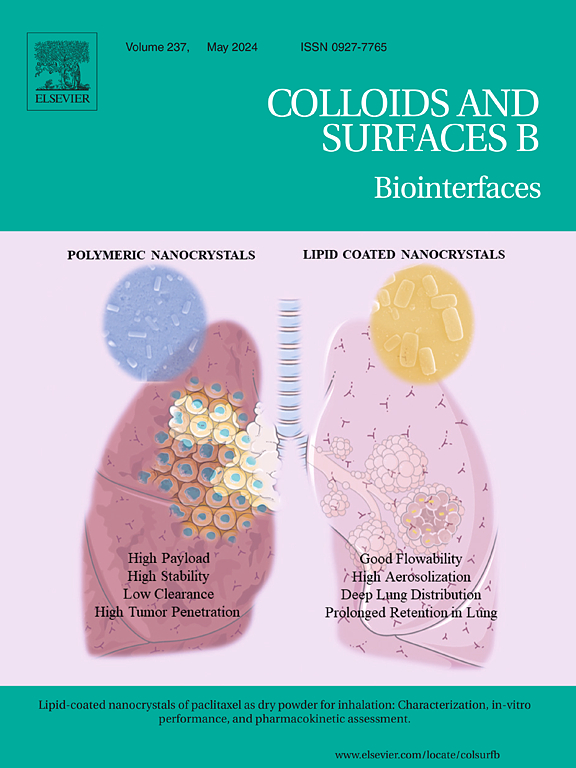生物医学应用中活性氧调控的纳米酶:设计、酶样活性和治疗机制
IF 5.4
2区 医学
Q1 BIOPHYSICS
引用次数: 0
摘要
纳米酶是一种人工合成的具有酶样活性的纳米材料,近年来由于其作为天然酶的可行替代品的潜力而引起了人们的广泛关注。它们表现出与天然酶相似的酶动力学特性,并具有几个优点,包括增强的稳定性,具有成本效益的存储和制备,可重用性和可扩展性。这些优点使得纳米酶具有广泛的应用前景。值得注意的是,纳米酶可以有效地调节活性氧(ROS),从而帮助维持生物系统内的动态氧化还原平衡,使这些纳米酶适合于ROS相关疾病的治疗,如炎症、神经退行性疾病和心血管疾病。另一方面,一些纳米酶可以通过ROS的产生来靶向和消除肿瘤细胞或病原体,从而为这类疾病的治疗提供了机会。纳米酶在制药领域的最新发展成就大大扩大了其在生物医学应用方面的潜力。本文就纳米酶的分类、酶样活性、催化机制及其在疾病治疗中的应用作一综述。此外,还讨论了纳米酶在生物领域面临的挑战和未来的发展前景。本综述旨在为多个生物医学领域的研究人员提供有价值的资源,为纳米酶在生物医学应用中的设计和应用提供见解。本文章由计算机程序翻译,如有差异,请以英文原文为准。
Nanozymes for regulation of reactive oxygen species in biomedical applications: Design, enzyme-like activity and therapeutic mechanisms
Nanozymes, which are artificially synthesized nanomaterials exhibiting enzyme-like activity, have garnered significant attention in recent years due to their potential as viable substitutes for natural enzymes. They demonstrate similar enzymatic kinetic properties comparable to natural enzymes and offer several advantages, including enhanced stability, cost-effective storage and preparation, reusability, and scalability. These advantages make nanozymes particularly opportunities for various applications. Notably, nanozymes can effectively regulate reactive oxygen species (ROS), thereby helping to maintain dynamic redox equilibrium within biological systems, making those nanozymes suitable for ROS-related diseases treatment, such as inflammation, neurodegenerative disorders, and cardiovascular diseases. On the other side, some nanozymes can be employed to target and eliminate tumor cells or pathogens through ROS generation, thus presenting opportunities for such disease treatment. Recent achievements in the development of nanozymes within the pharmaceutical field have significantly expanded their potential for biomedical applications. This review provides a brief overview of the classification of nanozymes, enzyme-like activity and catalytic mechanisms, and applications in disease treatment. Additionally, the challenges and future prospects of nanozymes in the biological field are also discussed. This review aims to serve as a valuable resource for researchers across multiple biomedical fields, offering insights into the design and application of nanozymes in biomedical applications.
求助全文
通过发布文献求助,成功后即可免费获取论文全文。
去求助
来源期刊

Colloids and Surfaces B: Biointerfaces
生物-材料科学:生物材料
CiteScore
11.10
自引率
3.40%
发文量
730
审稿时长
42 days
期刊介绍:
Colloids and Surfaces B: Biointerfaces is an international journal devoted to fundamental and applied research on colloid and interfacial phenomena in relation to systems of biological origin, having particular relevance to the medical, pharmaceutical, biotechnological, food and cosmetic fields.
Submissions that: (1) deal solely with biological phenomena and do not describe the physico-chemical or colloid-chemical background and/or mechanism of the phenomena, and (2) deal solely with colloid/interfacial phenomena and do not have appropriate biological content or relevance, are outside the scope of the journal and will not be considered for publication.
The journal publishes regular research papers, reviews, short communications and invited perspective articles, called BioInterface Perspectives. The BioInterface Perspective provide researchers the opportunity to review their own work, as well as provide insight into the work of others that inspired and influenced the author. Regular articles should have a maximum total length of 6,000 words. In addition, a (combined) maximum of 8 normal-sized figures and/or tables is allowed (so for instance 3 tables and 5 figures). For multiple-panel figures each set of two panels equates to one figure. Short communications should not exceed half of the above. It is required to give on the article cover page a short statistical summary of the article listing the total number of words and tables/figures.
 求助内容:
求助内容: 应助结果提醒方式:
应助结果提醒方式:


